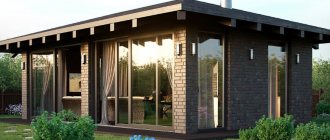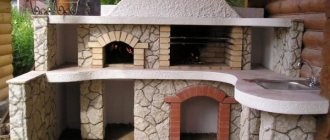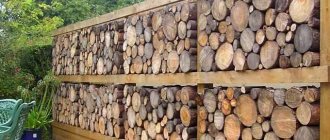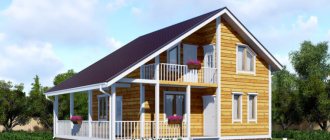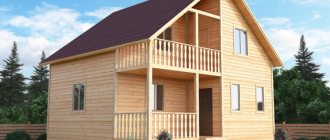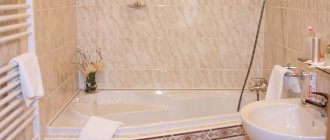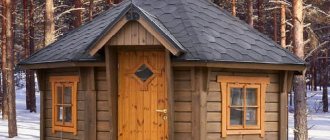Do you have your own house or summer cottage? Then this information is dedicated to you. The interior design of the yard is the pride of the owner. Of course, I want to show off the beautiful design. A flower garden will help make it so. An interestingly designed flower garden makes up 80% of a successful landscape design. We suggest using roses. You may think this is old and banal. But in fact, a rose can be different: refined, tender, playful, cheerful, noble, and accordingly, it gives this mood to the atmosphere, guests and owners.
The design of the yard should be beautiful, because this is the face of the owner
Roses are perfect for landscape design
Roses do not require special care
Advantages and disadvantages
If you still doubt whether you should use roses in your garden, let’s consider all the associated advantages and disadvantages of this choice.
Advantages
- Beauty. This is the first and most powerful argument. Whatever one may say, a rose is a flower of extraordinary beauty.
- A large assortment. At the moment there are many fans of this culture. And the breeders took care of them, providing a large selection of different species.
- Care. Roses do not require special feeding or very complex care.
Flaws. We figured out the only drawback: poor frost resistance. Roses are heat-loving plants, so the harsh Russian frosts are not to their liking. However, frost-resistant species already exist. In addition, a grafted rose is more resistant to frost. So this issue can be easily resolved.
The only drawback of roses is poor frost resistance
Roses will look very beautiful in your yard design
See also Conifers in the landscape design of a summer cottage
Choosing a landing site
Immediately before purchasing, you need to decide on the agrotechnical characteristics of the bush, its size and height, flowering characteristics, fullness and shape of the buds, and also select neighbors for the queen who will fill the voids in the rose garden. Among the abundance of varieties, it is recommended to choose those that were obtained by domestic or Dutch breeders. Seedlings must have a well-developed root system and be grafted at the time of purchase. The place should be chosen sunny, like any queen, the rose loves to bask in the rays of glory for everyone’s admiration. Only some varieties easily adapt to partial shade. If the plant does not have enough sun, the capricious queen will begin to wither and gradually fade away altogether.
Rose does not like high humidity. In the place where it is planted, the groundwater should lie as deep as possible, so it is preferable to choose hills for the rose garden. The soil is slightly acidic or neutral. If the land on the site does not meet this requirement, then imported soil will save the situation. The queen's root system needs a high-quality drainage system that will save it during periods of rain. Seedlings are dug into open ground only in late spring or early summer, when the soil has warmed up well.
The rose that appeared in the East requires the rising sun. Surprisingly, this need did not arise out of reverent attachment to the historical homeland. The reason is much more prosaic: roses are covered with dew in the morning. By lunchtime, its petals and leaves should be dried by the rising sun, since humidity will lead to the occurrence of fungal diseases.
Ideas
Since we have decided to use roses in garden design, let's look at interesting ideas on how to use them correctly. There are no specific strict options for arranging a site with roses - who said that you need to act one way or another? But within the framework of one project, established rules must be followed in order to achieve the desired result. Therefore, we offer possible ideas and schemes on how to turn them into reality.
| Site area | idea | Variety of roses |
| Front yard | Decorating a gazebo with roses, a row of bushes near the walls of the house | Curly, tea rose |
| Backyard | Arch, composition with a waterfall or pond | Curly, any type for composition |
| By the yard (outer part) | Hedge, flower garden | Low-growing frost-resistant |
Let's study in more detail the proposed options and ways to implement them.
You can arrange the site in any way
You can decorate anything with roses
Arches with roses in the garden will look very beautiful
See alsoEnglish garden landscape design: ideas with photos
Vertical rose garden
This option is very convenient for arranging a shady gazebo. Using climbing roses, you will achieve the desired effect and turn an ordinary gazebo into a fabulous corner. To do this, you need to plant the bushes at a distance of half a meter from the walls of the gazebo in a fairly dense row. Then you need to make fastenings. Drive short stakes into the ground next to the bush (so as not to damage the root), tie a thick rope to it (white twine is best), and secure it to the walls and roof of the gazebo in accordance with the pattern you want to achieve.
As soon as the rose begins to sprout, you need to guide it along the rope, thereby securing it to it. Then she will independently adhere to this support.
Another beautiful and unusual version of a vertical rose garden is an arch. Such an element in the landscape design of your site will give it some zest. It is built on the same principle as the frame of the gazebo, only instead of ropes, a metal arch becomes the support. If desired, you can attach several ropes to this base to give more volume to the composition.
As soon as the rose begins to grow, it needs to be directed in the right direction
Climbing roses will perfectly complement the landscape design of the yard
See also: DIY garden decor
Hedge
We are used to seeing hedges built from a certain type of bush. But you can also create it from roses. This idea will look even better, and especially when it blooms.
You can build such a miracle both in the front yard and in the backyard, and frame the path from the gate to the house. The composition will look advantageous in any area of the site and fulfill its function.
There is nothing complicated in its manufacture. The case is divided into several stages. The first is the most important stage: you need to draw a plan for the location of the fence. You can realize any ideas: from a simple line to the most bizarre shapes. In order not to get confused, and subsequently plant the bushes correctly, having achieved the desired pattern, do not ignore this stage.
Arches with roses will look very beautiful
Arches of roses will create a stunning atmosphere in the yard
You need to choose the color of roses carefully
We transfer the drawing to the surface of the earth. Having calculated the required space, the distance between the bushes and the shape of the fence, make notes on the areas of land intended for planting.
Let's move on to choosing roses. For hedges it is better to use low-growing bushes. They are usually compact and ball-like, so they can create a hedge effect, especially if planted close together. But make sure that the distance is sufficient for the normal functioning of the plant and the roots do not interfere with each other.
All that remains is to finish what we started and plant the bushes in the holes made in the previously designated places.
You can use tall or medium bushes. But they will leave gaps below, and by framing the path, they will interfere with free passage. The most advantageous option is the low-growing variety.
Roses can be combined with other flowers
You can combine roses with any number of flowers
See alsoWhat should be the design of the veranda?
Compositions
Let's get to the most interesting part. Here you can combine all landscape design techniques and turn your fantasies into reality.
When composing a composition, it is necessary to take into account all the nuances. Let's figure out what awaits us. In the overall score, pay attention to:
- location (shade, light, humidity);
- the presence of a strictly developed layout;
- number and type of roses;
- presence of other plants;
- compatibility of roses with other elements of the composition;
- ease of subsequent care.
So what do we mean? When using roses to create a composition with non-living elements, pay attention to whether there is enough space for the roots to develop, as well as ease of watering, and whether any elements will create an unfavorable atmosphere for the plant to grow (for example, a pond). When combining with other plants, be sure to ask whether they will take root together.
As in the previous option, this one requires a precise plan, even more strict. The main element in the proposed compositions will be an inanimate object (fountain, pond), and roses serve as an arrangement, so you need to concentrate attention on it. Make all the necessary measurements, calculate the required amount of space and material, and also create an accurate drawing of the location of objects. To do this, it is better to invite a landscape designer, which will significantly reduce your work and time.
So, many housewives dream of their own “swan lake”. Why not? It is quite possible to create it in your yard. Start with a pond. Make a good water supply and pumping system. We focus on the latter, since poor water circulation will lead to its blooming and the formation of an unpleasant odor.
When composing a composition, it is necessary to take into account all the nuances
When combining with other plants, be sure to ask whether they will take root together
It's easy to create stunning landscaping with roses
A “savage” stone is better suited for framing a pond. It will give a relaxed appearance. However, you can use any decorative stone.
Having completed the main part, we move on to the subsequent design. We organize planting of roses. In accordance with the planned plan, we plant the plants in the appropriate order. It is better to plant them at a short distance around the pond, or make flower beds nearby. A bench is well suited for such a composition. You can also decorate it with roses, and make a path leading to it from the pond, filling it with fine gravel and planting low-growing species along it.
The main detail in the next idea is a fountain. The first and second stages are no different. It is also necessary to draw a plan and purchase a good system for proper circulation of water in the fountain. Then complete the composition with roses.
You can also use a waterfall as a base - this combination will also be attractive. If you don't want to deal with water, make a dry pond. To do this, you need a frame made of any stone (as for a pond with water, only a low one). Fill the resulting shape with small pebbles, you can draw something inside, painting certain areas. To do this, use spray paint, or pre-soak groups of pebbles in another type of paint.
So, you can create any composition using everything at hand.
Roses in the yard will give a pleasant mood
Design can be created from available materials
See alsoModern landscape design. Main trends
Design style
First of all, you need to decide how to design the flower garden. It will be strictly rectangular, oval, or this shape will be free, not necessarily correct.
It's worth thinking about edging. One way to decorate it is with brick and marble chips, crushed stone and pebbles, or simply a low fence.
Even if you don’t adhere to geometric shapes, there should be order in the flowerbed, even if it’s creative.
Flowers and colors
When using roses in landscape design, they can be combined with other plants or inanimate objects (as in the examples above). To do this correctly and safely for the plant, pay attention to the following factors:
- plant compatibility (required amount of moisture, light, etc.);
- do artificial inclusions interfere with the normal growth of the flower;
- from an aesthetic point of view - color combinations.
These three factors are the main ones when arranging your garden and yard with roses. Be sure to monitor their implementation.
When selecting plants, consider compatibility
The color of the plants should be combined with other colors
Roses do not require special care
See alsoPlants for landscape design
What makes bush roses different?
- A variety of flower shapes - from classic to terry tea hybrids.
- Long flowering period from May to late autumn.
- Rapid growth - in the summer alone the bush can grow up to 2 m.
- Resistance to temperature changes and ease of maintenance.
- An unusual and strong aroma of flowers.
- Large selection of colors: from cream to lilac and even striped.
- Successful alternation of growth and death of flowers - the bush never ceases to bloom and delight with beauty.
- Shrub roses can be grown even at home in a regular pot.
The choice of one or another variety of roses depends on the goals of landscaping the territory. Many people completely change the position of the bushes and the details of the landscape of their summer cottage every two or three years.
Care
The key to a beautiful and long-living corner with roses is proper care. Naturally, the plant requires watering. When performing this task, monitor the required water level: do not overfill, but do not let it dry out.
Feed the flowers. Roses do not require special nutrition. However, they will benefit from additional soil nutrients.
The key to a beautiful and long-lived corner with roses is proper care
It is recommended to insulate roses for the winter
Meet the required lighting conditions in accordance with the type of plant.
Cover roses for the winter, as they are not frost-resistant.
As you can see, the rose is the queen of flowers, and everyone can cope with it. The main thing is proper care and creating a composition with a heart filled with love for flowers.
Expert opinion
Alina Kvileva
Landscape designer
Hello, my name is Alina and I am a landscape designer, if you have any questions regarding landscape design, ask, I will be happy to answer them.
See alsoWhat is needed for a site landscape design project
Vertical gardening
Decorating gazebos, terraces, arches, and facades in a vertical plane is an excellent solution not only aesthetically, but also protection from dust, noise, wind and summer heat. Climbing roses with medium and small flowers are suitable for this.
In combination with clematis and virgin grapes, they will create unique beauty and give an unforgettable experience.
Grape
The proximity of rose bushes to grapes is attractive to look at and very convenient to care for. Crops require the same agricultural technology, suffer from the same diseases, and prefer identical shelter for the winter.
Plants are placed around the perimeter of the site or around gazebos a meter apart from each other. The climbing rose looks most impressive in the company of grapes, rising along a support up to 1.5 meters in height.
Lavender
Lavender is an excellent protector against aphids and ants. With proper care, cultures form an incredibly beautiful duet. Lilac-pink flower beds decorate the garden paths, front entrance and seating areas.
For greater decorativeness, lavender is planted in groups, which during flowering creates the effect of a lush cloud. Both plants love the sun, so you should not place them too close to each other. Tall varieties of roses are tied to a support, providing light access to the soil around the bush.
Background plants
Rose is a special plant. It has a beautiful inflorescence, but the stems and leaves are of no aesthetic value. Usually they try to cover them with neighbors. Individual rose bushes planted in flower beds do not create a dense covering. These problems are solved by background plants.
Lavender, gypsophila, and sage look great next to roses.
Important! When forming a mixed flower bed, do not forget about the different needs of plants that suffer from an unfortunate neighborhood. For example, tall bushes take away light from sun-loving low-growing flowers. Also consider moisture tolerance, preferred soils, and more.
Large soft pink and raspberry roses look amazing next to small purple and lilac flowers
Khosta
During flowering, all the splendor of the rose bush is concentrated at the top. The lower part remains uncovered and, in most cases, looks inconspicuous. The host helps fill the space and add volume. A perennial ornamental grass with lush, often two-colored leaves, it grows in neat bushes on the lower tier.
Unlike roses, hosta prefers moist soil and light shade. To prevent such a flower bed from withering away after the first year of planting, you must try to please both crops at once. Suitable humidity is provided by a drip irrigation system.
Phloxes
Abundantly blooming phloxes are used as a background for low-growing varieties of roses and as a border for tall ones. When planting seedlings between the bushes, it is important to leave about a meter of free space. Constant air circulation prevents the development of most diseases, rot and fungus.
For the visual appeal of the flower bed, phloxes are chosen in one color. It is better to give preference to white inflorescences with brightly colored roses and vice versa. Excessive diversity will not allow you to enjoy the beauty of any of the cultures.
Accent plants
Roses are beautiful, but they get lost against the backdrop of large, brightly flowering plants. Therefore, when creating a mix with such options, they take a limited amount, no more than three. Try combining roses with tall herbs. Chinese miscanthus, reed grass, and spartina look gorgeous. Herbs seem simple, and this makes them the best neighbors for the aristocratic rose.
Related article:
5 basic fertilizers for roses
Conifers and roses seem to be inhabitants of different planets, but experiments with their combination give unexpected results. Surround the rose garden with columns of thujas, spread spreading bushes of creeping juniper along the edge - you will get a picture worthy of an artist’s brush.
Tall perennials with large flowers successfully share the role of accent details with roses. Plant plants in small groups, think about the compatibility of shades.
Delphinium
Delphinium inflorescences pointing upward are an excellent backdrop for a rose garden. The flowerbed can be made multi-colored or monochrome, consisting of two types or including dozens more plants.
It is not recommended to plant a rose close to a delphinium. The latter is distinguished by a well-branched rhizome that can inhibit surrounding plants.
Irises
Irises are classified as early flowering perennials. Purple-yellow, blue and almost black petals begin to fade in June. Despite this, irises retain their beauty even after flowering. It is actively used to create discounts and mixborders.
The sword-shaped leaves of the iris, reaching towards the sky, create a rich green background for the pink inflorescences. Plants are planted at a distance of 30-40 cm from each other to avoid conflict of root systems. Medium-sized varieties of roses are chosen for flower beds: Pastella, Golden Border, etc.
